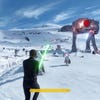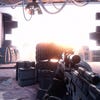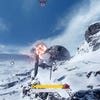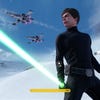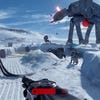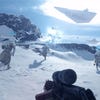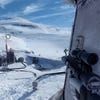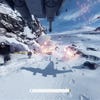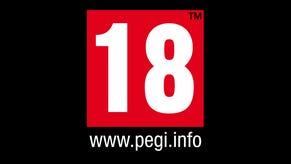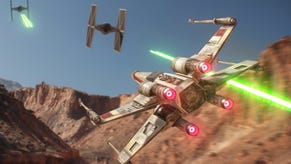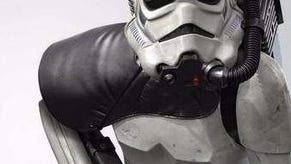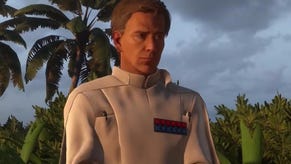Star Wars Battlefront on PS4 shows huge promise - but needs work
Digital Foundry analyses DICE's crucial console reveal.
With a show of work-in-progress gameplay footage - as captured from PlayStation 4 - Star Wars Battlefront's E3 demo was a genuine highlight of this year's event. Unlike its earlier April reveal (set to a woodland battle on Endor), it's also a far more realistic take on what to expect of PS4's multiplayer; a continuous run of on-foot and vehicular action around the snowy tundra of Hoth. But for all its flair, does it stack up to the game's impressive earlier reveal - and how is performance shaping up?
Before we go on, it's worth stressing that the "pre-alpha" PS4 gameplay we have here is likely to improve. There's still several months of development time left until Star Wars Battlefront's 20th November release in Europe - enough time to tweak its visuals and optimise performance further. Even so, our current analysis paints a fascinating picture of its progress so far, for the first time showing how DICE's series reboot actually plays on Sony's hardware.
First and foremost, the E3 Walker Assault footage is a genuine, practical look at console gameplay in motion. The PS4 capture is largely unedited, providing long stretches of action around the icy Hoth map, and letting us in on frame-rate and resolution details ahead of launch. Right away, from an early pixel-count we see the game matches the basic framebuffer setup of Battlefield 4 and Hardline: the evidence suggesting this PS4 build runs at a native 1600x900 with a pass of post-process anti-aliasing.
Despite the upscaled resolution, the game still looks good on Sony's machine (though in light of these metrics, we wonder if we'll see any improvement over Xbox One's limited 720p Battlefield presentation). From mid-air dogfights between X-Wings and Tie Fighters to on-foot battles against oncoming AT-AT walkers, DICE's work nails the aesthetic of the original films. And despite a confirmed cap of 40 players (lower than Battlefield 4's maximum 64), the scale of terrain is still broad enough to impress. However, it's fair to say its network of trenches and mountains don't come close to matching the sheer density of detail of the Endor woodland map shown in April.
Indeed, the early "in-engine" teaser showed an area very different in style: a map filled with giant redwood trees and a ceaseless run of action. It's a cinematic cut, rendered at a resolution beyond 1080p and likely down-sampled to achieve a crisper image, with a stutter-free frame-rate and footage chopped to give us an idealised vision of the game. Every shot is framed to flatter, opting for a filmic 2.35:1 letterbox setup as opposed to the standard 16:9 aspect ratio seen in the PS4 footage.
In other words, the early Endor teaser is more a demo for what Frostbite 3 is capable of, possibly given the right PC setup - an engine benchmark ahead of time. Though a direct comparison of this map on PS4 isn't possible yet, certain effects are evidently removed from the gameplay demo shown at E3. For starters the depth of field and a per-object motion blur are missing, while alpha transparencies lack the sharpness of this initial reveal. It's a setup that falls in line with Battlefield 4 on console, where motion blur is only engaged for campaign mode and cut from the multiplayer component. However, with no campaign mode due in Star Wars Battlefront, these effects show no signs right now of making a return. Even for crafted missions intended for split-screen play - such as this Horde mode fight on Tatooine - it appears there's no change from the PS4's multiplayer demo.
The E3 demo's presentation is far less cinematic as a result, but the sense of scale is still very much there. Though the Hoth map is nowhere near as densely packed as Endor's woodland, draw distances are vast with only minimal geometry pop-in when swooping down in an X-Wing. Up-close, character model detail is also close to the teaser's high standards. The only let-down is a sighting of a filtering cascade: when flying past other airborne vehicles, shadows far below appear blurred until it descends past a certain threshold. Otherwise, the game's approach to shadows quality and ambient occlusion is every bit as strong as the Battlefield series' appearances on console.
DICE's gravitation towards massive environments, vehicles and destruction still features, though notably with a slight re-balance to cater for the style expected of the Battlefront series. Between the teaser and PS4 gameplay demo, physics-based damage across the map evidently gets a lesser emphasis than in Battlefield 4 for example - something acknowledged by the team as a design choice. Besides the shrapnel flying from downed AT-AT walkers, or the flowing cloth physics on Rebel Alliance cloaks, actual use of physics is fairly limited. Future maps may introduce more procedural chip-damage in the vein of the DICE's other series, but for now this is an element that's been downsized in favour of a push for more concurrent vehicles.
Even with the Hoth demo's mostly white colour palette, there are neat visual touches not seen in the original teaser. Parallax occlusion mapping features heavily on this icy map for example, with footprints and indents lining the base of the trenches to give each surface a three-dimensional look. Backed by a specular component, the texture mapping for snow is convincing, especially as it's pitted against the Frostbite 3 engine's lighting model.
The push for physically-based rendering makes this possible. According to DICE's Siggraph 2014 notes, the technique demands strong real-life reference materials to deliver the most accurate lighting in-game. To that end, the team's access to Lucasfilm's Cultural Arts Museum - a vault filled with weapons and vehicles from the original trilogy - will have helped this project hugely. Along with trips to actual filming locations, the team could closely replicate objects and terrain from here, partly through a process termed 'photogrammetry.'
"Photogrammetry is essentially the technique of processing still images to produce a high resolution 3D mesh," lead environment artist Andre Hamilton explains. "There are a number approaches to this, but they all involve taking photos of a subject in real-life and running it through photogrammetry software."
With each prop scanned in, the team is able to determine mesh dimensions for use in-game, plus how lighting reacts with each surface's colour, opacity, roughness, or reflectance. The result is a level of authenticity to the Star Wars universe's look; one that sets its aesthetic far apart from the military grit of DICE's earlier Battlefield work.
All told, the PS4 demo highlights different benefits to using physically-based rendering to the teaser. A late appearance from Luke Skywalker shows how costume materials react naturally to Hoth's high contrast lighting; his lightsaber tinting the nearby snow as he runs forward, and their bloom appearing in Darth Vader's visor. Visually it all looks gorgeous in motion, though if there's one disappointment with the work-in-progress PS4 demo, it's not in its visuals, but in its performance.
A perfect 60fps on PS4 is seemingly not within reach right now. The E3 build is an explosive, open-ended 40-player match that rarely holds at this target number, besides the indoors segment right at the start. In this respect, performance is very similar to Battlefield 4 at its peak in multiplayer; a 40-50fps game for the general run of play that can dip into the 30s when pushed. In fact, speeding across the map in a Tie Fighter practically locks performance to 30fps for several seconds in our analysis, giving us the lowest figure across the demo.
Thankfully v-sync is engaged, but it's still clearly a long way from the silky smooth 60fps update we're looking for, even given the concessions in physics-based destruction and overall player count. Despite this, we're hopeful that the frame-rate reading will improve by release, and especially so far smaller-scale battles. After all, Battlefield Hardline did show extensive improvements between its beta debut at last year's E3 and its final release earlier this year.
After a decade of waiting for a true series successor (and seeing one false dawn pass by), DICE's reboot of Star Wars Battlefront shows huge promise - even if the reality of actual gameplay appears to fall short of the lofty ambitions presented in its April reveal. On a technical level, the E3 showing takes a step back in terms of post-effects quality in particular, and PS4's 1600x900 resolution and sub-60fps performance further separates it from that ideal. But even in this early multiplayer build, the Frostbite 3 engine, the team's pedigree in sandbox shooter design, and the subject material at hand all combine to show us a real progression from the Battlefield series before it.
A shift in priorities is noticed compared to DICE's earlier games too. For one, the lesser focus on physics-based destruction and 64-player battles is a notable change - two areas that hit performance hard in Battlefield 4 on PS4 and Xbox One. Instead, the game offers more vehicle interplay across a maximum pool of 40 players, with a superb use of physical-based rendering to vivify Star Wars' classic locales. All of which is a technical balance that should serve console performance better come release, especially given more time to optimise.
No doubt the team's early experiences with PS4 and Xbox One are an advantage as it builds on the current codebase, and we hope that this - along with the current PC closed alpha - staves off a repeat of Battlefield 4's buggy launch. But so far so good: the most exciting part is that Star Wars Battlefront has a few months to go before its November release. Despite falling short of the April trailer's dazzling high pitch (perhaps inevitably), it already gives us plenty to get excited about. The performance level on PS4 isn't ideal - and clearly work is needed there - but as an early indicator, it's at least on par with the team's previous games on Sony's hardware - and crucially, there's time to improve come release.




